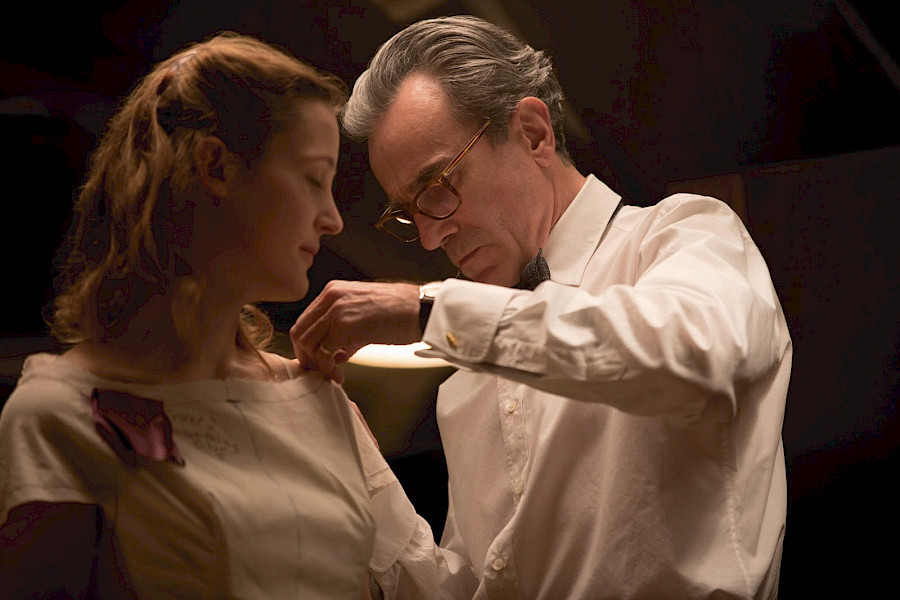
After World War II, the world of fashion underwent significant changes. With fabric scarcity, fashion leaned towards practicality, fostering an appreciation for the image of a strong woman navigating the challenges of a new era. Some designers rightly called the late 40s and early 50s the era of Cristóbal Balenciaga Eizagirre. His idea of women's clothing was both practical, with big hoods and "I" silhouette dresses, and a breath of fresh air in the realm of high fashion. Of course, his dedication to his craft didn't shield him from the deep loneliness every unique creator faces. As a result, Cristóbal closed all his fashion houses by the end of the 60s, without personally telling his employees about his radical decision. Embraced by solitude, he entered the twilight of his biography in the spring of ‘72.
Almost half a century later, one of the influential directors and screenwriters of the modern film industry, Paul Thomas Anderson, fell ill. His wife, the renowned comedic actress Maya Rudolph, became his caregiver. In her gaze, Thomas notices a tenderness and sincere love that he hadn't seen for a long time. This profound observation of love and intimacy becomes the inspiration for Anderson’s unconventional portrayal in the film "Phantom Thread." In 2017, Paul Thomas Anderson directed “Phantom Thread,” starring Daniel Day-Lewis (Reynolds Woodcock), Lesley Manville (Cyril Woodcock), and Vicky Krieps (Alma). The film tells the story of an English fashion designer from the mid-20th century, Reynolds Woodcock, who is meticulous, cold, some- times irritatingly indifferent, and deeply traumatised – a creator trapped in childhood memories marked by a deceased mother’s insufficient love and sister Cyril’s imposing presence, acting as a formidable barrier around the Woodcock high-fashion house. The ambiguous reflection of Woodcock’s story echoes the life of Cristóbal Balenciaga, serving as his prototype. Cristóbal grew up in a family where the father was a fisherman, and the mother was a seamstress. The father dies, and the mother becomes the muse of young Cristóbal, much like Alma in Anderson's "Phantom Thread" for Reynolds Woodcock, symbolically reflecting the yearning for a maternal presence.
Woodcock transcends the role of a mere fashion designer – he is the epitome of the history of haute couture masterfully adapted from the Spanish temper to the English, shamelessly transforming into the embodiment of the internal longing for the tender gaze of the author's wife in this film. Woodcock is haunted by the death of his mother, and he pours this emotion into the external world through a peculiar and distinctive habit – he inserts hidden stitches into the linings of the custom-made dresses. Within the cinematic reality, the meaning of these stitches is known only to Reynolds Woodcock, leaving us, as external observers, to feel the profound unease skillfully crafted by Paul Thomas Anderson.
In the throes of illness, Anderson encounters that very gaze of his spouse, which inspired "Phantom Thread." Scenes stitched with an invisible but palpable emotional thread clarify that the death of Reynolds Woodcock's mother, symbolised in hidden stitches, serves as a metaphor for the dormant, nearly forgotten true love for his wife. This affection lingers beneath the impenetrable layers of daily life, subtly manifesting itself in moments of weakness. Alma, recognising this depth, goes to extreme lengths, even poisoning Reynolds with mushrooms, just to elicit his love. It's after the illness that Woodcock proposes to Alma, recognising her strength. She saw vulnerability deep within his soul and dared to execute this cruel and manipulative act to demonstrate her power.
Even Cyril, with her strong character, didn't dare to oppose. A splendid dialogue between the author and his spouse transposed into the love story of a designer and a not-so-simple waitress.
Upon analysing the film, one may encounter details that shed light on why Daniel Day-Lewis left the film
industry – details that slightly opened the door to an existential crisis.
"It's comforting to think the dead are watching over the living. I don't find that spooky at all." – Reynolds Woodcock.
No, it’s not the dead who control Reynolds' fear and anxiety – it’s his escape from the profound truth of love that shatters all notions of discipline and personal boundaries. It's not unfounded to speculate that Lewis fell into depression after this film, struggling for a long time to rid himself of the demons of the main character. Daniel Day-Lewis is already known for his five-year breaks between films. The actor avoids interviews and leads a reclusive lifestyle, characteristic of masters of their craft. He is a proponent of the method acting approach aimed at developing sincerity, expressiveness, and emotional depth in performance. Undoubtedly, such an approach often guarantees a negative impact on health, but it is precisely this commitment that shapes Daniel into the artist he presents to the audience. In 2020, "The New York Times" ranked Daniel Day-Lewis third in the list of "25 Greatest Actors of the 21st Century." However, his hiatus extended for a considerable time, and perhaps even indefinitely – only time will tell. Costume designer Mark Bridges, honoured with awards from BAFTA, OSCAR, and the Satellite Awards for Best Costume Design, delivered truly impressive work. Among the employees of Woodcock's fashion house and in other episodic roles, real seamstresses and industry professionals participated. Day-Lewis, committed to his craft, studied archival materials from the 1940s-1950s, learned to sew, and insisted on fully immersing himself in the role of Reynolds Woodcock, even outside of filming.




